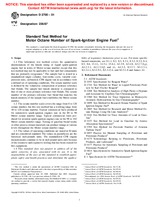We need your consent to use the individual data so that you can see information about your interests, among other things. Click "OK" to give your consent.
ASTM D2700-01
Standard Test Method for Motor Octane Number of Spark-Ignition Engine Fuel
STANDARD published on 10.9.2001
The information about the standard:
Designation standards: ASTM D2700-01
Note: WITHDRAWN
Publication date standards: 10.9.2001
SKU: NS-21216
The number of pages: 60
Approximate weight : 180 g (0.40 lbs)
Country: American technical standard
Category: Technical standards ASTM
Annotation of standard text ASTM D2700-01 :
Keywords:
aviation rating, guide table, isooctane, knock intensity, motor octane number, n-heptane, spark-ignition engine fuel performance, toluene standardization fuel, ICS Number Code 75.160.20 (Liquid fuels)
Additional information
| 1. Scope | ||||||||||||||||||||||||||||||||||||||
|
1.1 This laboratory test method covers the quantitative determination of the knock rating of liquid spark-ignition engine fuel in terms of Motor octane number except that this test method may not be applicable to fuel and fuel components that are primarily oxygenates. The sample fuel is tested in a standardized single cylinder, four-stroke cycle, variable compression ratio, carbureted, CFR engine run in accordance with a defined set of operating conditions. The octane number scale is defined by the volumetric composition of primary reference fuel blends. The sample fuel knock intensity is compared to that of one or more primary reference fuel blends. The octane number of the primary reference fuel blend that matches the knock intensity of the sample fuel establishes the Motor octane number. 1.2 The octane number scale covers the range from 0 to 120 octane number, but this test method has a working range from 40 to 120 octane number. Typical commercial fuels produced for automotive spark-ignition engines rate in the 80 to 90 Motor octane number range. Typical commercial fuels produced for aviation spark-ignition engines rate in the 98 to 102 Motor octane number range. Testing of gasoline blend stocks or other process stream materials can produce ratings at various levels throughout the Motor octane number range. 1.3 The values of operating conditions are stated in SI units and are considered standard. The values in parentheses are the historical inch-pounds units. The standardized CFR engine measurements continue to be in inch-pound units only because of the extensive and expensive tooling that has been created for this equipment. 1.4 This standard does not purport to address all of the safety concerns, if any, associated with its use. It is the responsibility of the user of this standard to establish appropriate safety and health practices and determine the applicability of regulatory limitations prior to use. For more specific hazard statements, see 8.1.1, 8.2, 8.3, 8.3.1, 8.3.2, 8.3.3, 8.4, 8.5, 8.6, 13.4.1, 14.5.1, 15.6.1, A2.3.9, A2.4.8, A3.2.7.2(g), A4.2.3.1, A4.2.3.3 (f) and (i) A4.3.5, X2.3.7, X3.2.3.1, X3.3.4.1, X3.3.4.1, X3.3.9.3, X.3.3.12.4, and X3.5.1.8 and Annex A1. |
||||||||||||||||||||||||||||||||||||||
| 2. Referenced Documents | ||||||||||||||||||||||||||||||||||||||
|
We recommend:
Technical standards updating
Do you want to make sure you use only the valid technical standards?
We can offer you a solution which will provide you a monthly overview concerning the updating of standards which you use.
Would you like to know more? Look at this page.




 Cookies
Cookies
